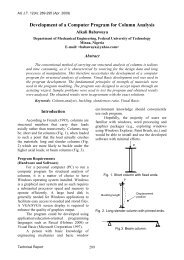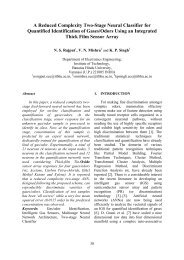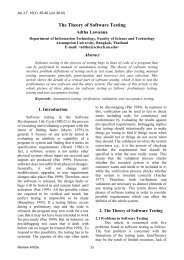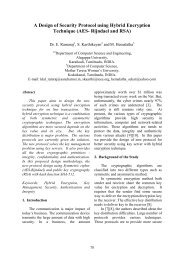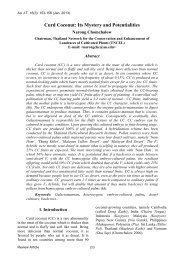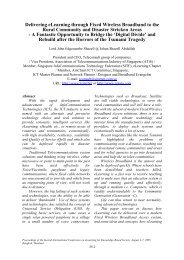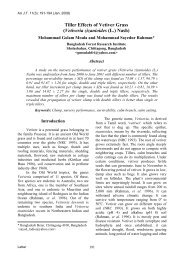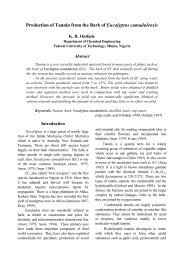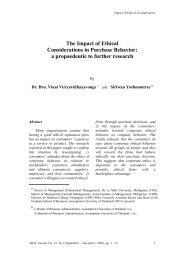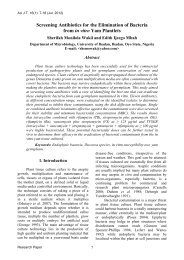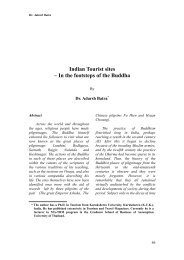PDF format - AU Journal - Assumption University of Thailand
PDF format - AU Journal - Assumption University of Thailand
PDF format - AU Journal - Assumption University of Thailand
You also want an ePaper? Increase the reach of your titles
YUMPU automatically turns print PDFs into web optimized ePapers that Google loves.
Research Results from the Study <strong>of</strong><br />
20 Tertiary Institutions in <strong>Thailand</strong><br />
Methodology And Survey Analyses<br />
Questionnaires<br />
A questionnaire consisting <strong>of</strong> 184<br />
questions on 28 pages was distributed<br />
to English language teaching staff in 20<br />
tertiary institutions in <strong>Thailand</strong>. In<br />
addition, a questionnaire consisting <strong>of</strong><br />
125 questions on 9 pages was<br />
distributed to students. The<br />
respondents answering the<br />
questionnaires were chosen by the<br />
Chairperson <strong>of</strong> the English Department<br />
or the Deans <strong>of</strong> the Faculty <strong>of</strong><br />
Humanity or the Faculty <strong>of</strong> Liberal<br />
Arts.<br />
Statistical Analyses <strong>of</strong> Both the<br />
Qualitative and the Quantitative<br />
Questionnaire Results<br />
T-test, Chi-square and Spearman<br />
Rho Rank Correlations are used where<br />
appropriate to analyse the results <strong>of</strong> the<br />
questionnaire. T-test is used because it<br />
can be applied to samples <strong>of</strong><br />
unrestricted sizes. The test is used to<br />
measure the means <strong>of</strong> two independent<br />
groups. However, in these cases, the<br />
same sets <strong>of</strong> questionnaires are used for<br />
different subjects, that is (1) lecturers<br />
from private and state institutions; and<br />
(2) students from private or state<br />
institutions. The results <strong>of</strong> the<br />
questionnaires match the assumptions<br />
underlying the use <strong>of</strong> t-test:<br />
1. the scores in each group are<br />
normally distributed and<br />
2 the variances for the scores <strong>of</strong><br />
the two groups are equal.<br />
(Myers & Well, 1991, p. 66).<br />
T-test is used in this study to<br />
compare questions where ranking is<br />
involved and the means differences are<br />
examined (for both lecturers’ and<br />
students’ questionnaires).<br />
Chi-square test <strong>of</strong> independence is<br />
used, for questions requiring Yes/No<br />
answers, to test hypotheses about<br />
proportions based on the frequencies <strong>of</strong><br />
the different categories <strong>of</strong> observational<br />
units observed in the sample. This is to<br />
determine whether or not a significant<br />
difference exists between the observed<br />
number <strong>of</strong> cases and the expected<br />
number <strong>of</strong> cases, that is, whether two<br />
variables are related or independent<br />
(Runyon & Haber, 1988, p. 417). A<br />
fundamental assumption in the use <strong>of</strong><br />
chi-square is that each observation or<br />
frequency is independent <strong>of</strong> all other<br />
observations (Runyon & Haber, 1988,<br />
p. 417).<br />
Spearman rho rank-order (or rankdifference)<br />
correlation coefficient is<br />
used with ordinal data (rank ordered)<br />
items for all the questionnaires in this<br />
study. However the data in these<br />
questionnaires are interval rather than<br />
ordinal in nature. The data size for the<br />
questionnaires used in this study is<br />
greater than the specified size <strong>of</strong> 30<br />
necessary for the application <strong>of</strong> this



